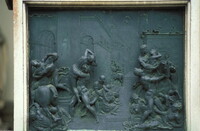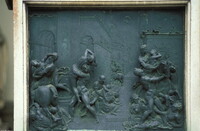| dc.coverage.spatial | Site: Florence, Tuscany, Italy | en_US |
| dc.coverage.temporal | 1582 (creation) | en_US |
| dc.creator | Giambologna | en_US |
| dc.date | 1582 | en_US |
| dc.date.accessioned | 2013-07-11T20:51:42Z | |
| dc.date.available | 2013-07-11T20:51:42Z | |
| dc.date.issued | 1582 | en_US |
| dc.identifier | 224501 | en_US |
| dc.identifier.other | archrefid: 600 | en_US |
| dc.identifier.uri | http://hdl.handle.net/1721.3/133076 | |
| dc.description | Bas-relief at base of sculpture, north side; Giambologna's third great marble group, the Rape of a Sabine (1582; Florence, Loggia Lanzi), represented the climax of his career as a figure sculptor, combining three figures into a cohesive group, an idea that had obsessed Michelangelo without his ever having been permitted to realize it in marble. The spiral composition means that the group cannot be fully comprehended from any single viewpoint. Technically, the sculpture is a masterpiece of virtuosity, pushing to its furthest limits the technique of undercutting, which Giambologna had observed in Hellenistic carving, and the use of which distinguishes his work so sharply from Michelangelo's. Source: Grove Art Online; http://www.groveart.com/ (accessed 12/2/2007) | en_US |
| dc.format.medium | marble | en_US |
| dc.rights | © Scott Gilchrist, Archivision, Inc. | en_US |
| dc.subject | mythology (Classical) | en_US |
| dc.subject | Mannerist (Renaissance-Baroque style) | en_US |
| dc.title | Rape of a Sabine | en_US |
| dc.type | image | en_US |
| dc.rights.access | Licensed for educational and research use by the MIT community only | en_US |
| dc.identifier.vendorcode | 6A1-GB-RS-D1 | en_US |
| vra.culturalContext | Italian | en_US |
| vra.technique | carving (processes) | en_US |
| vra.worktype | sculpture (visual work) | en_US |
| dc.contributor.display | Giambologna (Flemish sculptor, 1529-1608) | en_US |


